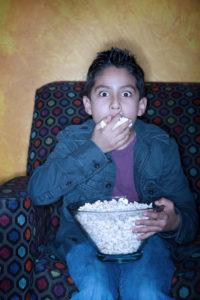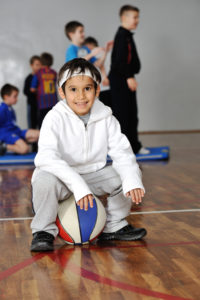Kids & Teens
Undoing Childhood Obesity
?It is well known that the United States faces a childhood obesity epidemic. In fact, 81% of respondents in a poll on the topic considered childhood obesity a serious concern and two-thirds believed the problem was getting worse (Hassink, Hill & Biddinger 2011). Actually, national surveys show a stabilization of childhood obesity rates and even small declines in some localities (RWJF 2012).
Corral the Kids
Since many schools no longer offer physical education, a lot of fitness professionals are volunteering their time before and after school. This is a great (and needed) community service, but unless you have experience working with kids aged 7–11, you may not be fully prepared for the challenge of corralling them for a cool-down. When kids are having fun, they don’t want to stop, listen and be quiet. The transition from a workout to a cool-down can be tough. That’s why you need a plan.
The following activities offer many creative ways to rein in kids.
Gray Institute Launches Nonprofit
To help address some of the problems facing youth today—physical inactivity, diabetes and obesity, among them—the Gray Institute has launched the not-for-profit Free2Play.
Utilizing the institute’s Applied Functional Science™, Free2Play aims to improve “movement literacy” and athleticism through “progressive” lesson plans available via online learning with on-demand access. Free2Play doesn’t replace health and fitness programs or curriculum.
Obese Children More Vulnerable to Food Advertising
When viewing food logos, obese children show less activity in regions of the brain associated with self-control than do their healthy-weight counterparts, reports The Journal of Pediatrics.
Researchers from the University of Missouri, Kansas City, and the University of Kansas Medical Center tested youth aged 10–14, using both self-reported measures of self-control and functional magnetic resonance imaging, which tracks blood flow as a measure of brain activity.
2012 Shape of the Nation Report
With health threats from overweight and obesity still looming, physical activity in schools continues to be a hot button. How do U.S. children rank when it comes to physical education and exercise? Here are some highlights from the 2012 Shape of the Nation Report: Status of Physical Education in the USA:
14% of students did not participate in at least 60minutes of physical activity on any day during the 7 days before the survey.
71% of students were physically active at least 60 minutes per day on fewer than 7 days during the 7 days before the survey.
Muscularity in Young Men Linked to Mortality Rates
That 98-pound weakling may want to hit the gym if he hopes to live a long life. A study published in the British Medical Journal (2012; 345: e7279) suggests that male adolescents without much muscle strength may earn early death in adulthood.
The large study included 1,142,599 Swedish males aged 16–19 who were followed for 24 years. The primary focus was to determine whether muscular strength had any impact on mortality rates. Premature death in this study was considered death before 55.
Food Marketing to Children and Adolescents: An Update
The Federal Trade Commission has released its Review of Food Marketing to Children and Adolescents, and the conclusions indicate that there is still much to be done if industry self-regulation of food marketing to children is to become an effective way to protect the health of minors. The 2012 report is a follow-up to the FTC’s 2008 report, which Congress requested in response to dramatic increases in childhood obesity rates.
Four of the Marketing Methods
Kids’ Sleep, Obesity and Electronic Devices
The rates of overweight and obesity among kids continue to climb. Food choices and inactivity are considered major culprits. Are electronic devices also to blame?
Scientists from the School of Public Health at the University of Alberta have linked use of electronic devices, poor sleep patterns and obesity among Canadian 5th graders. The researchers surveyed sleep habits, food intake, physical activity levels, height and weight measurements, and nighttime use of electronic devices among 3,398 children.
Prevention Is the Best Policy for Kids’ Obesity
Avery Faigenbaum, EdD, is a professor in the department of health and exercise science at The College of New Jersey. With a specialty in pediatric exercise science, he has authored…
Kids’ Fitness Interventions Failing
Childhood obesity, inactivity and poor food choices are taking a toll on today’s youth. In some cases, structured exercise is encouraged for weight management. Unfortunately, this approach doesn’t seem to be working.
Sample Class: Kids’ Kickboxing
Kids naturally love to move. Why not take advantage of their innate urge to wiggle? This kickboxing class not only helps kids strengthen their muscles and hearts; it also teaches body awareness, coordination and balance. You’ll even provide an environment that builds self-confidence; however, students won’t know that! They’ll just remember how much fun they had and will spend the rest of the day showing everyone the cool moves they learned in class.
Preadolescents, Obesity and Exercise
Preadolescence is a time of major change and growth, bringing psychological, physical and social shifts for boys and girls alike. Caught between the carefree days of childhood and the first throes of being a teenager, “tweens” (roughly aged 9–12) are a force to be reckoned with. Like many other populations, preadolescents are suffering from lack of exercise, which threatens to chart a course toward obesity and disease.
5 Tips for Teaching Teens
As the group fitness industry grows, so does its target audience. Now more than ever, teens (aged 13–19) are attending group classes. They’re popping into their moms’ yoga and Pilates…
Let’s Move! A View From the White House
Now that the presidential election is decided, it’s a good time not only to note the progress of First Lady Michelle Obama’s main initiative, Let’s Move!, but to explore how…
Modeling Lifelong Healthy Habits for Kids
Dr. Muth is a pediatrician, registered dietitian and board-certified specialist in sports dietetics (CSSD). Muth also serves as an ACE Senior Fitness Consultant and subject matter expert, regularly contributing to ACE blogs and to the ACE Certified News monthly newsletter. Her first book, Eat Your Vegetables and Other Mistakes Parents Make: Redefining How to Raise Healthy Eaters, was published by Healthy Learning in May 2012.
ACE: As a registered dietitian and pediatrician, what would you say is the biggest challenge we face in overcoming the obesity epidemic?
Child Diabetes Rates Higher in China than in the United States
While rising rates of diabetes and prediabetes in U.S. children have been causing alarm in recent years, youth in China appear to be faring far worse.
For Chinese teenagers the rate of diabetes is nearly four times higher than it is for their counterparts in the U.S., say researchers at the University of North Carolina at Chapel Hill, who examined data from the 2009 China Health and Nutrition Survey.
Raising Happy, Healthy Kids
You have probably read a lot about how today’s children are more overweight and obese than kids in past generations. But hearing actual statistics about the United States’ childhood obesity epidemic can be shocking.
Physical Education Compliance in Schools
A great deal of discussion has taken place regarding the importance of physical education (PE) in schools. Fortunately, many districts throughout the United States are required by law to offer…
Body Weight Bias Starts Early
Children are often thought of as “clean slates” when it comes to interpersonal relationships. However, researchers from Ryerson University in Toronto have found that children as young as 21/2 years…
Exercise for Young Athletes
What type of training will help your child improve at the sport he or she plays? Here’s what Brett Klika, director of athletic performance at Todd Durkin’s Fitness Quest 10 in San Diego, says, based on research and his extensive experience.

















